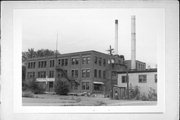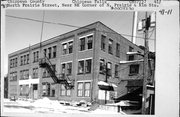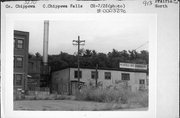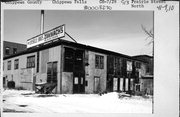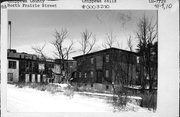| Additional Information: | A 'site file' exists for this property. It contains additional information such as correspondence, newspaper clippings, or historical information. It is a public record and may be viewed in person at the Wisconsin Historical Society, State Historic Preservation Office.
Brick facade divided by recessed brick panels; three over two windows; rough stone lintels; entrance with overlight altered; attached to metal covered warehouses on east and south sides; brick street in front of structure; metal exterior stairway; stone structure at rear also attached to complex.
Exhibiting a flat roof, recessed vertical window bays between brick piers and with flat masonry lintels over paired windows, the Mandelert Merchantile Company Building was probably constructed with a "modern steel" internal structural system in 1908 to house the offices, stock and ssewing room of the Mandelert Woolen Mills. (A) No historical ornament was used to ornament the rather utilitarian structure. The original structure, moved to the east and raised to a height of four floors, is attached to the rear of the brick office building. This structure originally of wood now covered with tin and the adjacent stone structure also located at the rear are in deteriorating condition.
Although no longer in use, the Mandelert Mercantile Company Building (Chippewa woolen Mill) has retained sufficient original architectural character to be an architecturally significant example typical of early 20th century industrial architecture in Chippewa Falls.
The north portion of the Woolen Mill is comprised of connecting additions which illustrate the earliest development of the mill. The original L-shaped portion of the mill, still partially visible on the northeast side, was built sometime between 1884 and 1886 for Chippewa Falls businessman Hactor McRae(B)(E). Sam Snyder was the architect. (H) In 1877, while owned by James Mitchell and Simon Cobban, the mill was partially ruined by fire.(F) Mitchell then purchased Cobban's share of the property and in turn sold part of the property to Hector McRae and George Wolfe.(B)(F) The mill was then incorporated under the name Chippewa Falls Woolen and Linen Mill. The mill closed but in 1890 was leased to J.L. Pierce and B.F.Millard and was operated under the name Crystal Spring Mills. After an undetermined amount of time, the mill was again shut down.(B) It resumed operation in 1893 under the owqnership of the French Lumbering Company (I). This company dissolved in 1902, with possession of the mill assumed by the newly formed Mandelert Mercantile Company (B)
In 1908, numerous improvements were made to the mill. The long portion of the L-shaped mill building was raised four feet and relocated thirty feet to the east, closer to Duncan Creek, leaving the mill inmore of a "T" shape. This portion was also enlarged to four floors instead of three, and veneered with tin. To make this part fireproof, a concrete insulation was placed between the original wooden exterior and the new tin veneer. This portion of the original mill, along with its stone foundation is visible on the northeast side of the present mill.(B)
In 1913, a stone building, originally 60 x 35 feet, was added to the southeast corner of the original mill.
These two metal warehouses, connected to the woolen mill on the south side, were constructed between 1910 and 1924 (A). At the time these buildings were constructed, the mill was owned by the Mandelert Mercantile Company and operated under the name of Chippewa Falls Woolen Company.(B)
As part of the historic development of the Chippewa Falls Woolen Mill Company, this portion of the mill is a historically significant representative of the arly industrial development of Chippewa Falls. This mill was one of four "primary processing" industries (flour, lumber, beer and woolen manufacture) which gave Chippewa Falls its earliest industrial base. |
|---|
| Bibliographic References: | HISTORIC NAME FOUND IN DOE.
A. Sanborn Insurance Map, City of Chippewa Falls, 1910, 1924.
B. Chippewa County Wisconsin Past and Present, vol. I (Chicago: The S.J. Clarke Publishing Company, 1913), pp. 268-269.
C. Chippewa County Wisconsin Past and Present, vol. I.
D. Sanborn Perris Insurance Map, City of Chippewa Falls (New York, 1910).
E. The Herald 30 July, 1884.
F. The Herald 18 May, 1887.
G. The Herald 6 August, 1884.
H. Chippewa Herald Telegram 17 January, 1962.
I. Chippewa Herald 16 June, 1893.
CORNELL AND LAKE HOLCOMBE COURIER 10/10/1996. |
|---|

